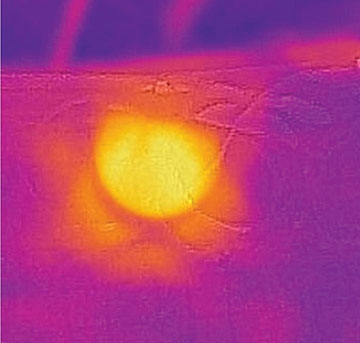
This image taken with an IR camera demonstrates the photoresponsive ability of nanosheets when exposed to near-infrared light. [Image: Texas A&M University]
Two-dimensional nanomaterials—which sport extreme thinness, chemical functionality and stability, and can respond rapidly to external stimuli such as light—are potentially useful for a wide range of biomedical applications. Now, researchers at Texas A&M University, USA, have developed a 2D nanosheet, a thousand times thinner than a human hair, that adsorbs near-infrared (NIR) light, converts it into heat and photothermally modifies cell behavior (Proc. Natl. Acad. Sci. USA, doi: 10.1073/pnas.1914345117).
The new paper’s authors say that it’s the first study to explore 2D nanosheets’ ability to control cell functions with light. The NIR-responsive materials could be significant for biomedicine, according to the authors, as NIR wavelengths can penetrate deep inside tissue to stimulate natural biological repair mechanisms. That, in turn, could set the materials up for applications ranging from drug delivery and cancer therapy to regenerative medicine.
Exploring emerging materials
Only a single layer of molecules thick, 2D nanomaterials have the highest specific surface areas of all known materials, making them well-suited for applications that require high levels of surface interactions on a small scale. This trait lends itself well to drug delivery systems, as nanomaterials could, in principle, absorb many drug molecules and enable control over release kinetics. Moreover, the ultrathin materials have been essential in some biosensing and gene-sequencing breakthroughs.
The thinness of 2D nanomaterials also allows the molecules to respond quickly to external stimulation—such as light. This property has led scientists to apply 2D nanomaterials to various optical therapies, including imaging applications and photothermal therapy.
Influencing gene regulation
In the current work, the Texas A&M team explored the photostimulation of 2D nanomaterials as a potential approach for influencing cellular activity—focusing in particular on photothermal modulation of 2D molybdenum disulfide (MoS2).
Bulk MoS2, a transition metal dichalcogenide (TMD), is composed of atomically thin sheets stacked by short-range van der Waals forces. In their experiments, the researchers chemically exfoliated MoS2 into individual nanosheets. Their high surface areas allow the nanosheets to readily stick to the surface of cells—a vantage point from which they can transmit signals to the cell nucleus and control cell behavior. The nanosheets can also be consumed by the cells, the authors say, and influence cellular functions from within.
Next, the researchers subjected cells that had been treated with nanosheets, along with some that hadn’t, to NIR light and performed high-throughput genomic analysis. They found that NIR-and-nanosheet-treated human stem cells showed change in approximately 157 genes, while cells that were only exposed to NIR light showed no significant change in gene expression. According to the researchers, genes related to integrins (a protein that regulates cell adhesion and motility), cellular migration and wound healing were significantly influenced by the NIR–nanosheet combination.
In further experiments, the researchers validated this effect by regulating the motility of cancer cells. The NIR–nanosheet treatment prevented cell movement—a potentially significant feature, as that’s how the disease spreads from tissue to tissue.
From cancer to robots
These results, the researchers say, suggest that NIR-stimulated MoS2 nanomaterials could be used to regulate gene expression on demand. For example, the nanosheet–NIR combination approach could be applied to cancer therapy or regenerative medicine.
Another area of research in the authors’ lab is using these nanosheets to design light-responsive soft robots. And considering the nanosheets are electrically conductive, their potential could even be explored for applications in wearable devices and remote monitoring, according to the team.
